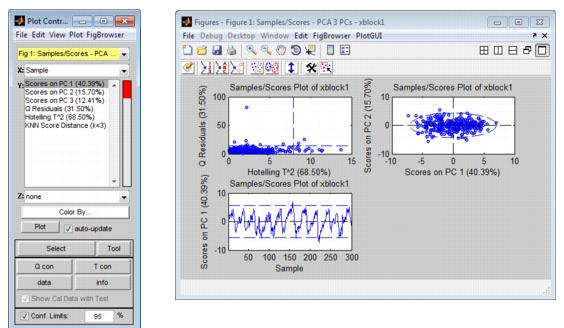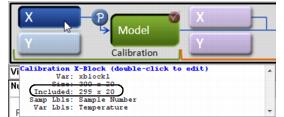Model Building: Plotting Scores: Difference between revisions
imported>Jeremy |
imported>Jeremy No edit summary |
||
| Line 98: | Line 98: | ||
:'''Note:''' Confidence Limits for PC versus PC plots are indicated by either a straight dashed line or an ellipse around the plotted data. As you change the value for the Confidence Limit, line moves in position or the ellipse expands or contracts in size accordingly. Data points that are inside the line or the ellipse, therefore, fall within the specified confidence limits. Conversely, data points that are outside the line or the ellipse exceed the specified confidence limits. | :'''Note:''' Confidence Limits for PC versus PC plots are indicated by either a straight dashed line or an ellipse around the plotted data. As you change the value for the Confidence Limit, line moves in position or the ellipse expands or contracts in size accordingly. Data points that are inside the line or the ellipse, therefore, fall within the specified confidence limits. Conversely, data points that are outside the line or the ellipse exceed the specified confidence limits. | ||
* For many factor-based models, you can view the Hotelling's T-squared and Q residuals contributions (T contribution and Q contributions) using the Qcon and Tcon buttons located on the Plot Controls dialog. See the [[T-Squared Q residuals and Contributions]] page for more information about these statistics. | |||
===Refining the model by excluding samples=== | ===Refining the model by excluding samples=== | ||
| Line 131: | Line 133: | ||
| | | | ||
* On the Plot Controls window, click T con, and then drag your cursor around a sample in the plot to open the T^2 Contributions dialog box. This dialog box shows the contribution of each variable that was measured for the sample to the T^2 value. | * On the Plot Controls window, click T con, and then drag your cursor around a sample in the plot to open the [[T-Squared_Q_residuals_and_Contributions|T^2 Contributions dialog box]]. This dialog box shows the contribution of each variable that was measured for the sample to the T^2 value. | ||
|} | |} | ||
| Line 140: | Line 142: | ||
| | | | ||
* On the Plot Controls window, click Q con, and then drag your cursor around a sample in the plot to open the Q Residuals Contributions dialog box. This dialog box shows the contribution of each variable that was measured for the sample to the Q Residual value. | * On the Plot Controls window, click Q con, and then drag your cursor around a sample in the plot to open the [[T-Squared_Q_residuals_and_Contributions|Q Residuals Contributions dialog box]]. This dialog box shows the contribution of each variable that was measured for the sample to the Q Residual value. | ||
|} | |} | ||
Latest revision as of 14:06, 28 June 2012
Table of Contents | Previous | Next
Plotting Scores and Statistical Values for a Calibration Model
For most analysis methods, the Analysis window toolbar contains a Plot scores and sample statistics button ![]() . Scores are the coordinates of the samples in the new principal component or factor coordinate system. A Scores plot shows the relationship among the samples in plots that are displayed in a multiplot Figure window. The Plot Controls window lists the options that can be plotted. The options that are available for plotting depend on the analysis that was carried out (for example, see Sample Classification Predictions.) To change the information that is plotted, select a different X value, a different Y value, or both in the Plot Controls window. The figure below shows some of the possible Scores plots for a PCA analysis in which three principal components were retained.
. Scores are the coordinates of the samples in the new principal component or factor coordinate system. A Scores plot shows the relationship among the samples in plots that are displayed in a multiplot Figure window. The Plot Controls window lists the options that can be plotted. The options that are available for plotting depend on the analysis that was carried out (for example, see Sample Classification Predictions.) To change the information that is plotted, select a different X value, a different Y value, or both in the Plot Controls window. The figure below shows some of the possible Scores plots for a PCA analysis in which three principal components were retained.
- Possible Scores plots for a PCA analysis in which three principal components were retained
Note: For information about the Plot Controls window and Plot window, see Plot Controls Window.
Options are available for changing the plot display and for examining and refining the model by excluding certain samples and/or variables to enhance the model performance. See:
Changing the plot display
Note: The examples listed here are not meant to be an exhaustive list of all of the available Plot Controls options for changing a Scores plot display. Instead, it is simply to provide representative examples of some of the more commonly used options when building a model.
|
|
|
|
|
- Note: The phrase "Decluttered" appears in the lower left hand corner of a decluttered plot.
|
- Note: Confidence Limits for PC versus PC plots are indicated by either a straight dashed line or an ellipse around the plotted data. As you change the value for the Confidence Limit, line moves in position or the ellipse expands or contracts in size accordingly. Data points that are inside the line or the ellipse, therefore, fall within the specified confidence limits. Conversely, data points that are outside the line or the ellipse exceed the specified confidence limits.
- For many factor-based models, you can view the Hotelling's T-squared and Q residuals contributions (T contribution and Q contributions) using the Qcon and Tcon buttons located on the Plot Controls dialog. See the T-Squared Q residuals and Contributions page for more information about these statistics.
Refining the model by excluding samples
Typically, when using Scores plots to refine a model, you identify samples that you consider to be unusual for the plotted data and then carry out a series of steps to determine whether to include the samples in the model, or to exclude the samples from the model.
Note: Typically, if you want to refine a model by removing variables, you use the information in a Loads plot. See Plotting Loads and Variable Statistics for a Calibration Model.
Note: The examples listed here are not meant to be an exhaustive list of all of the available Plot Controls options for refining a model using a Scores plot. Instead, it is simply to provide representative examples of some of the more commonly used options when building a model.
| 1. | Initially, you can do one or more of the following to review your samples, and determine which samples, if any, require further investigation: |
|
|
|
|
|
| 2. | For samples that you have determined require further investigation, you can do the following: |
- Note: "Lasso" is the most flexible tool for selecting samples.
- The color of the selected samples is changed, not only in the currently active plot, but also, in any other open plots that contain the samples.
| 3. | With the selected samples now highlighted in the plot, you can do one or more of the following to place the focus on the selected samples and glean further information about the selected samples before deciding to include them or exclude them for the model: |
|
|
|
|
| 4. | To exclude all of the selected samples from the model in a single step, on the Plot Controls window main menu, click Edit > Exclude Selection. |
|
|
- Note: After you exclude samples from a DataSet, point your mouse cursor on a control in which you have loaded data. Tooltip text opens indicating that number of samples that are being included in the model.
- Tooltip text indicating that number of samples that are being included in the model
|
|
At this point, you should iteratively repeat the steps of recalculating the model and then examining the model and refining the model by including or excluding samples until you are satisfied with the model. You can then do one of the following:
|
- Note: See Exporting_Models
|

